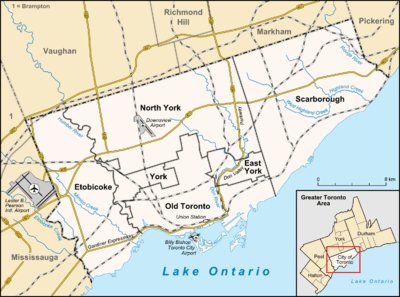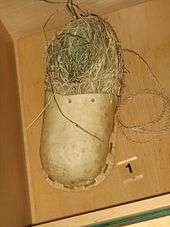Bata Shoe Museum
 | |
 Location of the museum in Toronto | |
| Established | May 6, 1995 |
|---|---|
| Location | 327 Bloor Street West, Toronto, Ontario, Canada |
| Coordinates | 43°40′02″N 79°24′01″W / 43.667278°N 79.400139°W |
| Type | Calceology |
| Curator | Elizabeth Semmelhack |
| Public transit access | |
| Website |
www |
The Bata Shoe Museum is a footwear museum in downtown Toronto, Canada, located at Bloor St. and St George St. in the Bloor St. Culture Corridor. The museum collects, researches, preserves and exhibits, footwear from around the world. It offers four exhibitions, three of which are time-limited, lectures, performances and family events. The collection contains over 13,500 items from throughout history, as well as the present. It is the only museum in North America dedicated solely to the history of footwear.
History
The collection which became the Bata Shoe Museum was started by Sonja Bata in the 1940s. As she travelled the world on business with her husband, Thomas J. Bata of the Bata Shoe Company, she gradually built up a collection of traditional footwear from the areas she was visiting.
In 1979, the Bata family established the Bata Shoe Museum Foundation to operate an international centre for footwear research and house the collection. From 1979 to 1994, the collection was stored at the offices of Bata Limited in the Don Mills area of Toronto. In June 1992, the Bata Shoe Museum opened a gallery on the second floor of the Colonnade, an office and retail complex in downtown Toronto, where it remained until November 1994. On May 6, 1995, the current museum opened its doors to the public in its own newly constructed building.
Building

Designed by Raymond Moriyama and completed in 1995, the structure is located at the southwest corner of Bloor and St. George streets in downtown Toronto. Its form is derived from the idea of the museum as a container. Associating the form with footwear, Moriyama stated that the building is meant to evoke an opening shoe box; it has a deconstructivist form with canted walls and a copper-clad roof offset from the walls of the building below in an interesting play of volume and void. The main facade (north) along Bloor Street pinches inward to where the entrance, in the form of a glass shard, emerges, creating a more generous forecourt. This glass protrusion is one end of a multi-level 'cut' through the building which contains the main vertical circulation, providing a clear view through the building to the three-story faceted glass wall, designed by Lutz Haufschild, on the south facade. The entire stone volume appears to float above a ribbon of glass display windows on street level; the limestone glows in late afternoon sunlight.

Raymond Moriyama was asked by his client Sonja Bata to create a “small gem of a museum” to house her extensive shoe collection. After viewing her collection, Moriyama strove to create a building that generated the excitement that he felt when first viewing the collection. He wanted to create a museum that would endure time, and inspire its visitors. Moriyama explained: “When I first viewed the collection, I was impressed by the array of shoe boxes that protected the shoes from light, moisture, and dust and played an important role in the collection.” His focus was on the idea of a container or shoebox.
Raymond Moriyama said of the building: "Architecture is never the creation of the architect alone. The museum's architecture should be seen as a celebration not only of shoes but also of the wonderful vision that brought them into the public eye."
The Museum is part of the Bloor Street Culture Corridor, a mile in Toronto that contains 13 museums and cultural institutions.[1]
The Bata Shoe Museum was featured in an episode of The Amazing Race: Family Edition, for which the contestants were in Toronto. Teams had to choose a pair of shoes, and find the woman who fit the selected pair amongst 100 candidates.
Galleries and collections

The museum is home to the world's largest and most comprehensive collection of shoes and footwear-related artifacts. The publicly accessible part of the building consists of four stories, which contain four galleries, two lecture and multi-purpose rooms, a gift shop, and a lobby, as well as offices and conservation facilities.
The circulation core has the exhibition galleries to the east, gift shops to the west, and multipurpose rooms, special exhibition showcases and rooms, and the administrative desk. An enclosed courtyard runs across the south side of the building. Two lower levels are dedicated to an exhibition gallery, and the shoe research and storage room. The gallery spaces are neutral in design, allowing focus on the creative displays rather than the building. Traditional materials such as cast bronze and leather (an important material in shoe creation for centuries) are used in signage throughout the museum.
The museum is featuring four main exhibits: 'All about Shoes: Footwear Through the Ages;' 'Beauty, Identity, Pride: Native North American Footwear;' 'Collected in the Field: Shoemaking Stories from Around the World;' and 'Fashion Victims: The Pleasures and Perils of Dress in the 19th Century'.

At present, the permanent collection contains artifacts from virtually every culture in the world. One of the most important aspects of the museum's holdings is an extensive collection from Native American and circumpolar cultures. The museum's assortment of celebrity footwear is a popular attraction; it includes ballroom slippers worn by Queen Victoria, the monogrammed silver platform boots of Elton John, a Terry Fox running shoe, white and blue patent loafers of Elvis Presley and John Lennon's Beatle boot.
The museum usually houses four exhibitions, one semi-permanent and three time-limited and changing. The semi-permanent exhibition, All About Shoes: Footwear Through the Ages, features diverse footwear from many historical periods and geographic areas, and looks at its significance in various cultural practices and phases of life. The three changing exhibitions are usually on display for one to two years, and may focus on a specific time period, cultural group, geographic area, or an aspect of material culture. The footwear on display, often remarkable for its construction and/or embellishment, also acts as a key to understanding its times, and illustrates social and cultural developments.
Past exhibitions
- 'All About Shoes: Footwear Through the Ages (May 1995 – ongoing)
- Inuit Boots: A Women’s Art (May 1995 – May 1996)
- One, Two, Buckle My Shoe: Illustrations from Contemporary Children’s Books about Shoes (May 1995 – April 1996)
- The Gentle Step – The Ladies Realm of Fashion 1800 – 1900 (May 1995 – February 1997)
- Shoe Dreams: Designs by Andrea Pfister (May 1996 – January 1997)
- Tradition and Innovation: Northern Athapaskan Footwear (June 1996 –June 1997)
- Rock and Sole – Basketball footwear (February 1997 – November 1997)
- Dance! - Minuet to Disco (March 1997 – February 1999)
- Loose Tongues and Lost Soles: Shoes in Cartoon and Caricature (spring – fall 1997)
- Footwear Fantasia: Shoe Sculptures by Garry Greenwood (April – November 1997)
- The Taming of the Shoe: From Attic to Exhibition (November 1997 – October 1998)
- Spirit of Siberia (June 1997 – June 1998); Dance! (March 1997 – February 1999)
- Little Feats: A Celebration of Children’s Shoes (October 1998 – May 1999)
- Footsteps on the Sacred Earth: Southwestern Native Footwear (July 1998 – June 1999)
- Japanese Footgear: Walking the Path of Innovation (February 1999 – January 2000)
- Herbert and Beth Levine: An American Pair (June 1999 – December 1999)
- Paduka: Feet and Footwear in the Indian Tradition (July 1999 – June 2000)
- Every Step a Lotus: Shoes in the Lives of Chinese Women from Late Imperial China (2001)
- Heights of Fashion: A History of the Elevated Foot(2001)
- The Perfect Pair: Wedding Shoe Stories (2002–2004)
- Paths Across the Plains: Native Footwear of the Great Plains (2004–2005);
- Icons of Elegance: Influential Shoe Designers of the 20th century (2005–2007);
- Watched by Heaven, Tied to Earth: Summoning Animal Protection for Chinese Children (2006–2007);
- The Charm of Rococo: Femininity and Footwear of the 18th century (2006–2008);
- Beauty, Identity, Pride: Native North American Footwear (2009 - closing date TBA);
- On Pointe:The Rise of the Ballet Shoe(2008-2009)
- On a Pedestal: From Renaissance Chopines to Baroque Heels (2009 - September 20, 2010);
- Socks: Between You and Your Shoes (2010)
- Art in Shoes/Shoes in Art (2010)
- Roaring 20’s: Hemlines, Heels and High Hopes (2011)
- Roger Vivier: Process to Perfection (2012)
- Collected in the Field: Shoemaking Traditions from Around the World(2013)
- Out of the Box: The Rise of Sneaker Culture (2013)
Research and programs

The Bata Shoe Museum conducts and sponsors research into understanding of the role of footwear in the social and cultural life of humanity. Through acquiring, conserving, researching, communication and exhibiting material evidence related to the history of footwear and shoemaking, the museum illustrates the living habits, the culture and the customs of people. Its international collection of over 13,500 artifacts spans 4,500 years of history.
The Bata Shoe Museum Foundation has funded field trips to collect and research footwear in Asia, Europe, and circumpolar regions and cultures where traditions are changing rapidly (Siberia, Alaska, Greenland, the Canadian Inuit and the Saami people). The foundation has also produced academic publications, many of which are available online or in the museum's store.
The museum organizes lectures, performances, and social evenings, often with an ethnocultural focus or community partner. Events often illuminate a personal connection or a cultural context in which footwear was created. Themed family activities have included Family Fun Weekends, as well as special events featuring storytelling, music, arts and crafts, and trying on unusual and funky shoes. The museum holds an annual "Warm the Sole Sock Drive" fundraiser, which begins on World Kindness Day, to collect socks for donation to a local charity. An annual lecture series, The Founder's Lecture is held each November and is an annual, public event featuring an internationally recognized leading thinker engaged with the convergence of culture and society. Past lecturers have included Harold Koda, Margaret Visser and Karim Rashid.
The museum is affiliated with CMA, CHIN, Virtual Museum of Canada, Ontario Association of Art Galleries, and North American Reciprocal Museums.
Educational outreach
Approximately 10,000 students come to the museum every year on field trips. Teachers, students and non-students alike also visit the museum's online exhibitions: On Canadian Ground: Stories of Footwear in Early Canada and All About Shoes, which latter features artifacts and information from some of the Museum's most popular exhibitions. All About Shoes also provides teachers' resources with classroom activities and projects. The BSM educational program Step Ahead subsidizes curriculum-based museum education programs for at-risk children. Currently backed in part by BMO Financial Group, Step Ahead gives school children in at-risk communities the opportunity to participate in the Museum’s education program at no cost.
Arms
 |
|
See also
Notes
- ↑ "Bloor St. Culture Corridor -". Bloor St. Culture Corridor. Retrieved September 10, 2014.
- ↑ "Archive". Archived from the original on September 6, 2014. Retrieved September 10, 2014.
- ↑ Canadian Heraldic Authority (Volume III), Ottawa, 1995, p. 10
References
- "Mtarch.com Bata Shoe Museum: Case Study". Moriyama & Teshima Architects. Archived from the original on April 17, 2012. Retrieved April 7, 2012.
External links
| Wikimedia Commons has media related to Bata Shoe Museum. |
- Official website
- All About Shoes virtual museum
- On Canadian Ground: Stories of Footwear in Early Canada